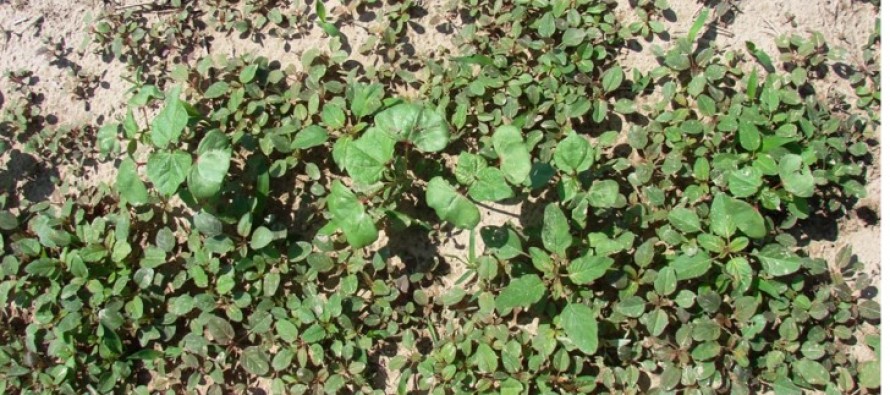- No posts where found
Managing PPO-resistant Palmer Amaranth in Mississippi Cotton

Related Articles
- Fertilizing Cotton with Poultry Litter 5
- Flag The Technology 0
- Mississippi Cotton Insect Situation of 2010: A Look Back 3
Latest Tweets
Based on results of greenhouse screening, fields located in Bolivar, Coahoma, Sunflower, and Tunica counties or in counties adjacent to these could likely contain Palmer amaranth resistant to protoporhyrinogen oxidase (PPO) herbicides (herbicide Group 14) in 2016. Commonly used PPO herbicides in Mississippi include Aim, Cobra, fomesafen (Reflex, Flexstar, various generics), Sharpen, sulfentrazone (one of the active ingredients in Sonic and the Authority line of herbicides), Ultra Blazer, and Valor SX.
The presence of PPO-resistant Palmer amaranth will complicate herbicide programs in affected areas. Most populations of Palmer amaranth in the Mississippi Delta exhibit multiple resistance to glyphosate and ALS herbicides (herbicide Group 2; Classic, Envoke, Regiment, Staple). Other populations are resistant to glyphosate, ALS herbicides, and DNA herbicides (herbicide Group 3; Prowl, Treflan). Herbicide selection will be severely limited in cotton fields that contain Palmer amaranth exhibiting multiple resistance.
Development of glyphosate-resistant Palmer amaranth in Mississippi left growers with no broadcast postemergence herbicide options for control of this species in Roundup Ready Flex cotton. Therefore, growers have become accustomed to relying exclusively on residual herbicides to manage Palmer amaranth in Roundup Ready Flex cotton. Additionally, for those who have grown LibertyLink varieties, Liberty 280 (herbicide Group 10) has become one of the go-to products for Palmer amaranth control in multiple crops.
Herbicide suggestions for Palmer amaranth control in Mississippi cotton have included preplant applications of Valor SX and/or Reflex. Residual applications of PPO herbicides still exhibit some level of control of PPO-resistant waterhemp (a pigweed species closely related to Palmer amaranth) in midwestern states. However, the level of control and length of residual is lower on resistant compared with susceptible populations. Preliminary data from the University of Arkansas shows a similar response in PPO-resistant Palmer amaranth.
Because data suggests that residual applications of PPO herbicides may still provide at least suppression of PPO-resistant Palmer amaranth and because of the limited herbicide options in Roundup Ready Flex cotton, herbicide suggestions for Palmer amaranth control in Mississippi cotton will remain unchanged in 2016. However, a few critical components of the program should be emphasized this year.
- Include paraquat (herbicide Group 22) with any preplant/preemergence herbicide application. Paraquat remains effective for Palmer amaranth control before crop emergence. However, widespread use of paraquat has placed extreme selection pressure on this species.
- Scout carefully to assess the effectiveness of preplant residual herbicide applications. This is critical to ensure no Palmer amaranth is emerged at planting.
- Apply fluometuron (herbicide Group 7) as a preemergence treatment at planting. Fluometuron represents one of the few remaining herbicides modes of action effective for Palmer amaranth control.
- Include a chloroacetamide herbicide (herbicide Group 15; S-metolachlor, metolachlor, or Warrant) with the first postemergence application.
- Apply a layby herbicide treatment containing diuron (herbicide Group 7).
The only postemergence herbicide that offers control of multiple resistant Palmer amaranth after crop emergence is Liberty 280 (herbicide Group 10). In cotton, Liberty 280 may be applied to LibertyLink, Bollgard II Xtend Flex, Enlist, or Widestrike cotton varieties. Liberty 280 is primarily a contact herbicide, so weed size at application, application volume, nozzle selection, and time of day of application are all critical to optimize herbicide performance.
Managing Palmer amaranth with multiple resistance to glyphosate, ALS, and PPO herbicides will be complicated; however, excellent control of this species is still feasible. Please contact us if you suspect a problem.





Let me tell You a sad story ! There are no comments yet, but You can be first one to comment this article.
Write a comment